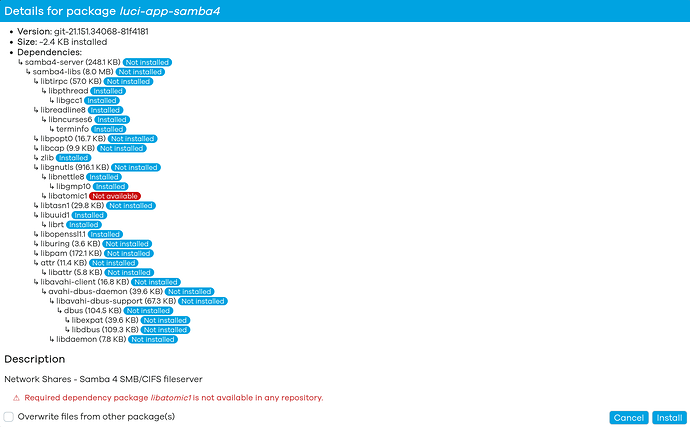Also can't install samba:
root@LinksysMR9000:~# wget https://downloads.notengobattery.com/projects/openwrt-v3.0.0-rc4/packages/arm_cortex-a7_neon-vfpv4/notengobattery_feed/Packages.gz
Downloading 'https://downloads.notengobattery.com/projects/openwrt-v3.0.0-rc4/packages/arm_cortex-a7_neon-vfpv4/notengobattery_feed/Packages.gz'
Connecting to 3.20.183.177:443
Connection error: Invalid SSL certificate
root@LinksysMR9000:~#
Click 'CA' at the bottom-right, you will see the upload button for the manual FW updates.
Hi, I want to check if there's a openwrt FW and upgrade process for MR9000?
Yes it works, more info in this thread:
Hi reka, I used the MR9000 .dts file here as the template and built a hacked firmware (21.02.0-rc4) for an MR6350 September last year. The firmware has been working smoothly since. Thanks for the trailblazing work you did to MR9000. Now I am thinking of upgrading the MR6350 to a tri-band router and it comes down to either MR8300 or MR9000. I would prefer MR9000 to MR8300 if both are in the stable OpenWrt release. But at this moment, MR9000 is not and I am wondering if you have a timeline of when that may happen, assuming you are working on it.
To tell you the truth , I'm not actively working on it so regrettably there is no timeline.
Understood. I know enough to build firmware but not technical enough to understand dts or kernel internal but but build a 'hacked' firmware is quite troublesome when one only does it once in a while. I actually have lost all the details of what I did last year. I guess I will just go with MR8300 but there is no rush.
Hi!
Sorry for recover this old thread, but I recently purchased 2 of this on amazon prime, and seems that the router is "locked" to 450mbs on the 3rd band. I've installed the NoTengoBattery firmware, and configured both routers with WDS (performance is best that mesh). Two routers sync with a 1733 speed, but the maximum I can get is 450mbs. With the oem firmware and mesh, performance seems similiar. Do yo have any improvement since last year?
I think these are "CPU" limited to about 450 Mbps...
Strange, i have done some test installing iperf and config as a server, and cable performance is about 780mb, iperf config as client, cable performance is 980, So the limit shouldn't be the cpu
So is there much to do to get this into OpenWRT official release? And anyone care to give a performance comparison vs the OEM firmware?
Is this still the case?
Is it possible just to fool Openwrt into thinking the MR9000 is just a MR8300?
When I try and install OpenVPN-OpenSSL via luci I get the following:
Open source VPN solution using OpenSSL
Required dependency package kernel is not available in any repository.
Then the following when I click on "Allow overwriting conflicting package files":
Collected errors:
- pkg_hash_check_unresolved: cannot find dependency kernel (= 5.15.118-1-686af171eaf2fa281363e0d571f20576) for kmod-tun
- pkg_hash_fetch_best_installation_candidate: Packages for kmod-tun found, but incompatible with the architectures configured
- pkg_hash_check_unresolved: cannot find dependency libc for liblzo2
- pkg_hash_fetch_best_installation_candidate: Packages for liblzo2 found, but incompatible with the architectures configured
- pkg_hash_check_unresolved: cannot find dependency libc for libopenssl3
- pkg_hash_fetch_best_installation_candidate: Packages for libopenssl3 found, but incompatible with the architectures configured
- pkg_hash_check_unresolved: cannot find dependency libc for openvpn-openssl
- pkg_hash_fetch_best_installation_candidate: Packages for openvpn-openssl found, but incompatible with the architectures configured
- opkg_install_cmd: Cannot install package openvpn-openssl.
I am on a generic 23.05.0rc2 on my MR9000 all is working fine other than it's not recognising the kernal and as such isn't liking installing software.
Would love to get this working so I can install nordvpn on my router.
You really, really, really shouldn't even try, there are separate images for a reason - even in case the devices are very similar.
For the rest, expected behaviour:
